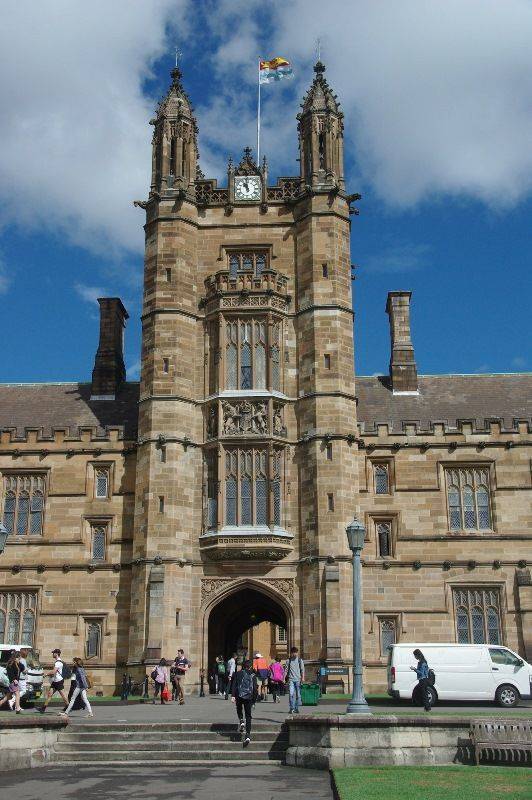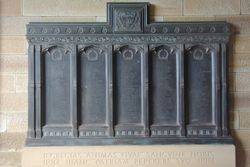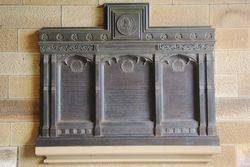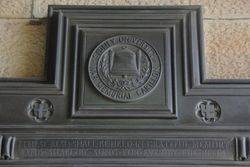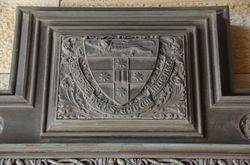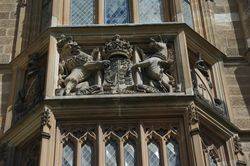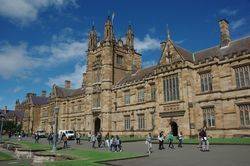
Home » Themes » Conflict » World War One
Sydney University War Memorial CarillonPrint Page 
The Sydney University War Memorial Carillon commemorates the undergraduates, graduates and staff who died in service or were killed in action during World War One.
The entrance to the carillon contains various honour rolls including the University Roll of Honour which was unveiled on the 11th November 1931.
Originally, the Carillon consisted of 62 bells giving 49 notes, the top octave bells being in duplicate. The instrument was played at a keyboard of manual and pedal levers. For a short time, a pneumatic keyboard was also used. In 1973, the top bells were returned to the original founders for recasting and, at the same time, five additional small bells were cast. The rebuilt carillon now has 54 bells and a range of four and a half octaves. The 23 lower bells were cast by the Taylor bellfoundry, of Loughborough, England. The upper 33 treble bells were cast by the Whitechapel bellfoundry of London.
Last November, the University War Memorial Executive Committee decided that every endeavour should be made to inaugurate the carillon on Anzac Day of this year. The plan depended chiefly upon the arrival of the bells, the playing mechanism, and the expert to supervise their erection, while there was still time before Anzac Day for the necessary four or five weeks' work. Our cablegram from London, published on the 23rd of last month, announced that the carillon was to be shipped from London by the steamer Port Gisborne, leaving on January 26. The agents say that the steamer did not get away till the 28th, but that she will reach Sydney only one day later than originally determined, namely, March 12.
In the circumstances, the executive committee is pushing on with its preparations for Anzac Day. And if all goes well Sydney ought to witness the inauguration of a really great war memorial practically complete in it essentials. The clock tower of the University has been appropriated by the Senate to the purposes of the war memorial, and permission has been given for the installation of a new clock that will have, as the original architect intended, a face on each of the four sides of the tower, and that will also strike the hours upon the great bell of the carillon, and use other and smaller bells for little snatches of music at clock hour according to any plan that the University pleases to adopt. This represents the first definite improvement of the memorial beyond the specifications of the contract let to the bell founders. The first sound of the memorial bells at the inauguration will doubtless send a thrill through all privileged to hear it.
Arrangements seem not yet to have been made for an appropriate part to be taken by the inaugural and dedicatory ceremonies at the University in the whole scheme of Anzac Day. As the authorities, military as well as scholastlc, have not yet had an opportunity of coming to a decision, no sure information has yet to be had. But will Sydney do itself justice if it does not somehow make the inauguratlon of the first carillon in Australia, as a memorial to the war heroes of Australia, an event that will be long remembered- one comparable in its way to the impressive ceremonial in London, when the memorial to the guards' regiments was unveiled, at the Houseguards, with all London intent upon it, some two years ago? The really great artistic war memorials are few, and Sydney is to have one that is, for Australia, unique in kind, and sure to remain among the noblest that it will ever know.
The Sydney Morning Herald (NSW), 3 February 1928.
Tomorrow, Armistice Day, at Sydney University there will take place the dedication by the Anglican Archbishop of Sydney and unveiling by the Governor of what is an essential portion of the university's War Memorial -the roll of honour. It should be explained that not merely the carillon (now three and a half years old) but the whole great tower of the University constitutes the memorial, the tower having been formally appropriated for this purpose and transformed by gradual stages to its special use.
The idea that the self sacrifice of many young lives should be commemorated by means of these sweet tones, echoing every hour through the University cloisters and other buildings, had an appeal far wider than the University, and many men, women, and groups of citizens grasped at the notion of giving a bell in memory of a son, a friend, or old comrades. The largest bell was given by the whole Faculty of Art- in memory of the A.I.F.; and, in addition to the sacrifice of individual soldiers, there has been commemorated by the gift of a bell or of subscriptions towards one the loss of old boys of Armidale School, of members of the University Club, of men of several colleges, of suburbs and towns, of players of the Rugby Union, who played their last great game on the battlefield, of the nurses of the A.I.F., of the 3rd and 34th Battalions, the stretcher bearers of the 17th, the 6th, and 7th Light Horse Regiments, members of the old New South Wales Scottish Rifles, the engineers, the signallers, the dental service, and very many others. These names stand on a supplementary roll of honour on one side of the great archway, surmounted by the medallion (designed by Mr. J. D. Moore) by means of which certain funds were raised for the carillon.
It is on the other side of the great archway, however, that there stands the list of over 200 names which is the main motive for the memorial-the University's own honour roll. The Virgilian lines at its foot may be translated: "Noble spirits, who with their blood won this our country for us."
The Sydney Morning Herald (NSW), 10 November 1931.
Location
| Address: | University Place , The Quadrangle, University of Sydney, Camperdown, 2050 |
|---|---|
| State: | NSW |
| Area: | AUS |
| GPS Coordinates: | Lat: -33.885853 Long: 151.189197 Note: GPS Coordinates are approximate. |
Details
| Monument Type: | Structure |
|---|---|
| Monument Theme: | Conflict |
| Sub-Theme: | WW1 |
| Actual Event Start Date: | 04-August-1914 |
| Actual Event End Date: | 28-June-1919 |
| Link: | http://www.warmemorialsregister.nsw… |
Dedication
| Actual Monument Dedication Date: | Wednesday 25th April, 1928 |
|---|
(Honour Roll)
(Names)
EGREGIAS ANIMAS OVAE SANGVINE
1914 HANC PATRIAM PEPERERE SVO 1918
(Honour Roll)
SYDNEY UNIVERSITY
MEMORIAL CARILLON
THESE ALSO BE HELD IN GRATEFUL MEMORY
AND SHALL BE SUNG FOR EVER BY THE BELLS
(Names)


